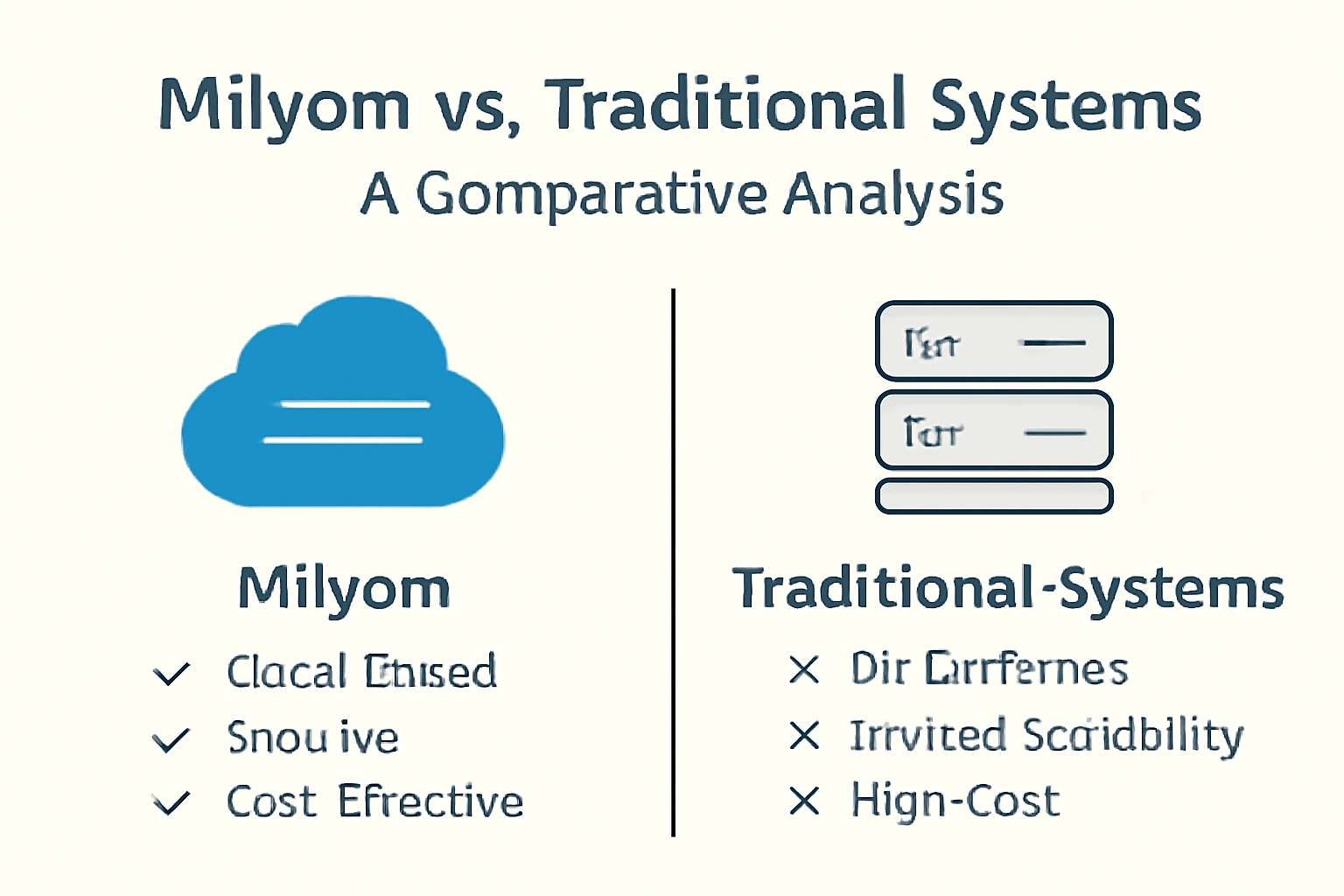Introduction: Understanding Milyom vs. Traditional Systems
In today’s rapidly evolving technological landscape, organizations are constantly seeking efficient solutions to enhance productivity and streamline processes. One of the most significant debates in this context revolves around Milyom vs. traditional systems. While traditional systems have been the backbone of operations for decades, Milyom introduces a modern, innovative approach designed to overcome the limitations of legacy structures. This comparative analysis will explore the core differences, advantages, and potential challenges associated with both approaches, helping businesses make informed decisions about system adoption.
What Are Traditional Systems?
Traditional systems, often referred to as legacy systems, are established methods of managing business operations, data, and workflows. These systems rely on conventional infrastructure and manual processes to handle tasks ranging from record-keeping to transaction management. Key characteristics of traditional systems include:
-
Centralized architecture: Data and operations are managed through a single, central server or database.
-
Manual intervention: Many processes require human input, leading to higher chances of errors and delays.
-
Rigid workflows: Traditional systems are often inflexible, making it challenging to adapt to new business requirements.
-
Limited scalability: Expanding or upgrading traditional systems can be costly and time-consuming.
Despite these limitations, traditional systems have long been valued for their reliability, predictability, and proven track record in maintaining operational continuity.
Introducing Milyom: The Modern Alternative
Milyom represents a new paradigm in system design, integrating advanced technologies to optimize efficiency, adaptability, and data management. Unlike traditional systems, Milyom leverages cloud computing, automation, and real-time analytics to deliver a more dynamic approach to business operations. Key features of Milyom include:
-
Decentralized architecture: Milyom distributes data and processes across multiple nodes, reducing single points of failure.
-
Automation and AI integration: Routine tasks are automated, minimizing errors and freeing up human resources for strategic activities.
-
Scalability and flexibility: Milyom adapts easily to growing business needs, supporting dynamic workflows and rapid expansion.
-
Enhanced data insights: Real-time analytics enable informed decision-making and proactive problem-solving.
By addressing the limitations of traditional systems, Milyom offers a comprehensive solution for organizations seeking innovation, efficiency, and competitiveness in a digital-first world.
Comparative Analysis: Key Differences Between Milyom vs. Traditional Systems
To understand the practical implications of adopting Milyom over traditional systems, it is essential to examine their differences across several critical dimensions.
1. Efficiency and Performance
Traditional systems: Operations are often slowed by manual processes, outdated infrastructure, and limited integration capabilities. Performance may degrade as data volume increases.
Milyom: Automated workflows and optimized processing algorithms significantly enhance efficiency. Real-time data access ensures faster decision-making and smoother operations.
2. Scalability and Adaptability
Traditional systems: Scaling requires substantial investment in hardware, software, and human resources. Modifying processes to meet new requirements can be challenging.
Milyom: Cloud-based architecture and modular design allow seamless scaling. Businesses can add new functionalities and adjust workflows with minimal disruption.
3. Data Management and Security
Traditional systems: Centralized databases are vulnerable to single points of failure. Data security relies heavily on manual oversight, and disaster recovery can be cumbersome.
Milyom: Decentralized systems enhance resilience, while advanced encryption and automated backup mechanisms ensure robust data security and quick recovery in case of failures.
4. Cost Implications
Traditional systems: Initial setup and ongoing maintenance can be expensive due to hardware requirements, software licensing, and labor costs.
Milyom: Cloud-based delivery reduces upfront costs. Automation and optimized resource utilization lower operational expenses over time.
5. User Experience and Accessibility
Traditional systems: Interfaces are often complex and not user-friendly. Remote access may be limited, reducing flexibility for employees.
Milyom: Modern user interfaces, mobile access, and intuitive design improve user experience, making it easier for teams to interact with the system efficiently.
Advantages of Milyom Over Traditional Systems
Adopting Milyom offers several strategic advantages for organizations, particularly in the context of modern business demands:
-
Faster decision-making: Real-time insights empower leaders to respond quickly to market changes.
-
Reduced operational risk: Automation and decentralized architecture minimize errors and vulnerabilities.
-
Future-proof infrastructure: Milyom’s flexible design supports evolving technologies and business models.
-
Cost efficiency: Lower maintenance and operational costs enable better resource allocation.
-
Enhanced collaboration: Cloud access and intuitive tools facilitate seamless teamwork across locations.
Challenges and Considerations
While Milyom presents numerous benefits, organizations must also consider potential challenges:
-
Implementation complexity: Transitioning from a traditional system to Milyom requires careful planning and training.
-
Integration with legacy systems: Organizations may need hybrid solutions during migration to ensure continuity.
-
Dependence on internet connectivity: Cloud-based operations rely on stable and secure internet access.
By proactively addressing these considerations, organizations can maximize the benefits of Milyom while mitigating potential risks.
Real-World Applications of Milyom
Milyom’s versatility allows it to be applied across various industries, including:
-
Healthcare: Streamlining patient records, appointment scheduling, and diagnostics.
-
Finance: Enhancing transaction processing, fraud detection, and reporting.
-
Manufacturing: Optimizing supply chain management, production planning, and quality control.
-
Education: Facilitating remote learning, student management, and analytics.
These applications highlight how Milyom’s innovative approach outperforms traditional systems in delivering efficiency, accuracy, and adaptability.
Conclusion: Choosing Between Milyom vs. Traditional Systems
The choice between Milyom vs. traditional systems ultimately depends on an organization’s priorities, resources, and long-term goals. Traditional systems remain valuable for their reliability and familiarity, but they struggle to keep pace with modern demands for flexibility, scalability, and real-time insights. Milyom, with its advanced technology integration, automation, and cloud-based infrastructure, offers a forward-looking solution that addresses the limitations of legacy systems.
For businesses aiming to embrace innovation, improve operational efficiency, and remain competitive in a digital-first environment, adopting Milyom provides a clear strategic advantage. By carefully assessing organizational needs and planning a smooth transition, companies can successfully harness the benefits of Milyom while minimizing disruption.

